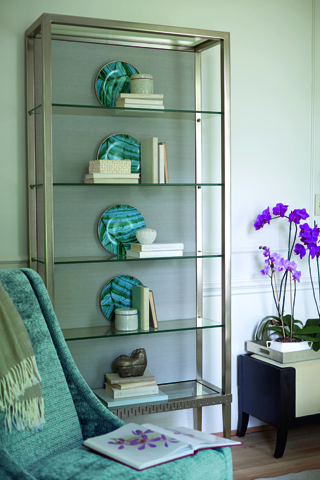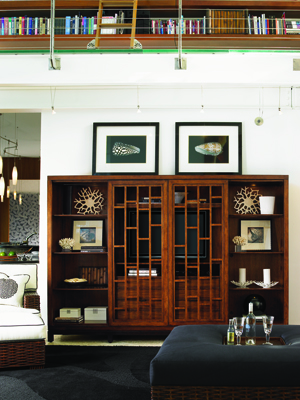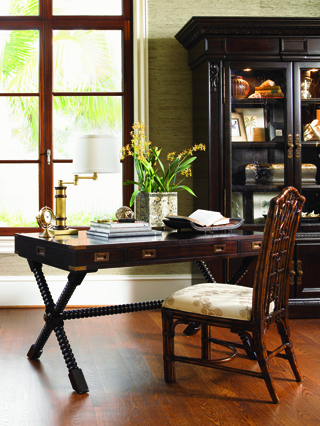Decorative ways to store a book collection
By Leah A. Zeldes, Tribune Content Agency
"People who love books, they like to have them accessible," says Syril Lebbad, a designer for Baer's, a collection of fine furniture stores with 15 locations throughout Florida.
 As more and more reading matter becomes electronic, actual books become cherished artifacts as well as valuable collectibles and heirlooms. "In the future, your grandmother's 2007 Kindle won't work, and no one will be able to fix it," warns book and paper conservator James Twomey of Book Restoration Co.
Although electronic books are handy to tote around, few people retain obsolete plastic gizmos as relics.
As more and more reading matter becomes electronic, actual books become cherished artifacts as well as valuable collectibles and heirlooms. "In the future, your grandmother's 2007 Kindle won't work, and no one will be able to fix it," warns book and paper conservator James Twomey of Book Restoration Co.
Although electronic books are handy to tote around, few people retain obsolete plastic gizmos as relics.
But books can be forever, with many collectors devoting entire rooms to books. If you have the space, notes Brenda Clark, another Baer's designer, "There are some really pretty library walls that have a functional ladder. People love those."
Most of us integrate our books into living space. And if you have a large, mixed collection, avoiding that used-bookstore look can be tough.
Rather than crowd all the books into one room, Lebbad advises, "think of putting books in different places." Perhaps some can go on a shelf below a coffee table, or inside a closet. You could group books by subject in different rooms.
Avoid stuffing those bookcases full. "When you completely fill a bookcase, it's very heavy," Lebbad says. "Leave room for air."
She recommends leaving spaces amid the books to intersperse knickknacks, and putting some short stacks of books on their sides to break up that library look. Handsome boxes let you dispense with bookends, or use books stacked flat to hold up the upright volumes and break up the appearance of all those straight spines.
 You can also get away from the library look by mixing up the bookcases. Different shapes, sizes and colors of bookcases can create a contemporary look.
You can also get away from the library look by mixing up the bookcases. Different shapes, sizes and colors of bookcases can create a contemporary look.
Another trick for changing the look of your book collection is to create blocks of color by making paper dust covers, suggests Baer's designer Wendy Rossi. That also hides any books that may look scruffy.
Twomey cautions that you should use only alkaline-buffered paper, to keep damaging acid from migrating from the paper to the book cover.
If your well-loved volumes look shabby, you can get bookcases with solid doors. Solid doors can break up the look of row and rows of books and keep those beloved but less aesthetic volumes out of sight.
Enclosed bookcases help protect your books, says Twomey. For those books you'd like to see, he recommends glass doors, or — even better — doors made from UF-3 plexiglass, which blocks harmful ultraviolet light and helps to reduce changes of humidity as seasons change and you open the windows or turn on the air conditioning.
The level of humidity matters less than keeping a constant humidity, he says. "A book does not benefit from breathing."
 For the most special books — say, the family bible or that heirloom first edition — you can protect the volume while turning it into a decorative objet d'art, Twomey says, with plexiglass cubes that rest on a beautiful wood stand. "That shouts, 'This is a special book!'" he says. There are also clamshell storage boxes for books, some of which are made to look like books themselves.
For the most special books — say, the family bible or that heirloom first edition — you can protect the volume while turning it into a decorative objet d'art, Twomey says, with plexiglass cubes that rest on a beautiful wood stand. "That shouts, 'This is a special book!'" he says. There are also clamshell storage boxes for books, some of which are made to look like books themselves.
"When people have a book that they value — whether for market value or sentimental value — they like to have it in a prominent place," says Twomey. However, to keep that precious volume in the best condition, the more enclosed the book is the better. "The larger the world around the book the more hazards there are." Sunlight, changing humidity, dust and other things common to homes can damage books.
From a preservation perspective, Twomey says, the ideal atmosphere for books would have a relative humidity of 10 percent and a temperature of 0 degrees Fahrenheit.
In order to slow down the aging process of the ephemeral artifact, Twomey says, you need to strike a balance between visual access to the book and creating a microenvironment around it.

